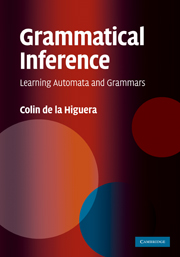Book contents
- Frontmatter
- Contents
- Preface
- Acknowledgements
- 1 Introduction
- 2 The data and some applications
- Part I The Tools
- Part II What Does Learning a Language Mean?
- Part III Learning Algorithms and Techniques
- 11 Text learners
- 12 Informed learners
- 13 Learning with queries
- 14 Artificial intelligence techniques
- 15 Learning context-free grammars
- 16 Learning probabilistic finite automata
- 17 Estimating the probabilities
- 18 Learning transducers
- 19 A very small conclusion
- References
- Index
19 - A very small conclusion
from Part III - Learning Algorithms and Techniques
Published online by Cambridge University Press: 05 July 2014
- Frontmatter
- Contents
- Preface
- Acknowledgements
- 1 Introduction
- 2 The data and some applications
- Part I The Tools
- Part II What Does Learning a Language Mean?
- Part III Learning Algorithms and Techniques
- 11 Text learners
- 12 Informed learners
- 13 Learning with queries
- 14 Artificial intelligence techniques
- 15 Learning context-free grammars
- 16 Learning probabilistic finite automata
- 17 Estimating the probabilities
- 18 Learning transducers
- 19 A very small conclusion
- References
- Index
Summary
On two occasions I have been asked [by members of Parliament], ‘Pray, Mr. Babbage, if you put into the machine wrong figures, will the right answers come out?’ I am not able rightly to apprehend the kind of confusion of ideas that could provoke such a question.
Charles Babbage“Was it all inevitable, John?” Reeve was pushing his fingers across the floor of the cell, seated on his haunches. I was lying on the mattress. “Yes,” I said. “I think it was. Certainly, it's written that way. The end of the book is there before the beginning's hardly started.”
Ian Rankin, Knots and CrossesWhen ending this manuscript, the author decided that a certain number of things had been left implicit in the text, and could perhaps be written out clearly in some place where this would not affect the mathematical reading of the rest.
Let us discuss these points briefly here.
About convergence
Let us suppose, for the sake of argument, that the task we were developing algorithms for was the construction of random number generators. Suppose now that we had constructed such a generator, that given a seed s would return an endless series of numbers. Some of the questions we may be faced with might be:
• Is 25 more or less random than 17?
• Is 23 random?[…]
- Type
- Chapter
- Information
- Grammatical InferenceLearning Automata and Grammars, pp. 391 - 393Publisher: Cambridge University PressPrint publication year: 2010



